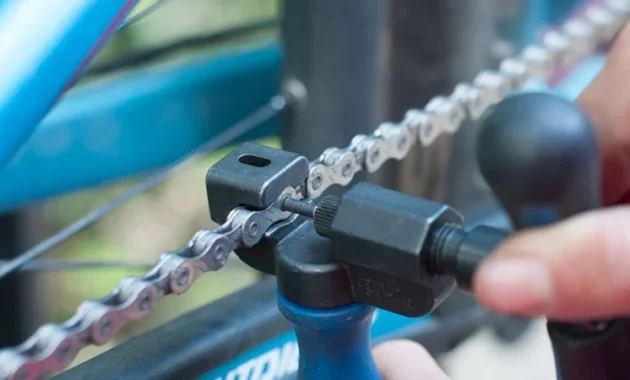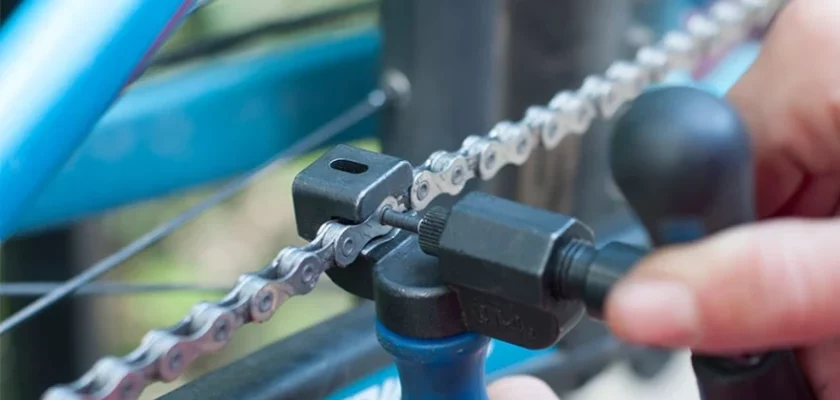A bike chain is important because it transfers the power from the rider’s legs to the wheels, which moves the bike forward. Breaking a bike chain is sometimes required, like when you need to replace a worn-out chain, get rid of a broken chain, or fix a mechanical problem.
Anyone who rides a bike needs to know how to break a bike chain so that upkeep, repairs, and upgrades can be done. Break a bike chain safely with this tutorial.
Why Do We Need To Break A Bike Chain?
Often, you need to break a bike chain to do upkeep, repairs, or upgrades to your bike. It’s all about making sure your bike is in great shape and that your ride is smooth and fun.
One usual reason is that the whole chain needs to be changed. Bicycle chains can wear out over time and cause problems like skipping gears or irregular turning.
When this happens, it’s best to start over with a whole new chain. When you break the chain, A new, shiny chain will make your bike smoother and faster.
Breaking a bike chain is also necessary when you are cleaning or fixing your bike. To keep your chain from rusting and to make sure it works well, you should keep it clean and oiled.
Breaking the chain makes it much easier to clean those hard-to-reach spots and get rid of any dirt or grime that might be getting in the way of your gears.
You might need to break the chain sometimes to make fixes or make changes. If you want to replace worn-out gear or chainrings, you have to take the chain off first. In the same way, breaking the chain makes it much easier to switch out your back wheel or make adjustments to the derailleur.
At first, breaking a bike chain might sound scary, but don’t worry! It’s simple to work with the correct equipment, such as a chain tool.
Tools To Break A Bike Chain
You’ll need a special tool called a chain tool or chain breaker to break a bike chain. This handy tool lets you take the chain links apart so you can do maintenance or fixes on them. Some of the most essential requirements are as follows:
Chain Breaker
This tool is made to break bike chains and put them back together again. It has a handle, a pin, and something that drives the pin. You can take the chain apart by using the pin to push out the screws that hold the chain links together.
I can suggest to you 3 chain breakers I have used till now.
1. Park Tool CT-5 Mini Chain Brute Chain Tool
The tool can work with 1/8″ single-speed chains and 5–12-speed derailleur chains. Its shelf makes tight links easy to remove, restoring chain functionality. To ensure long-term use, the tool allows pin replacement (part # CTP). At 77 grams, it fits into a bike backpack or pocket and can solve chain troubles on the fly.
The CT-5 Mini Chain Brute is compact, measuring 60mm x 55mm x 15mm. Its small size makes it a useful cycling accessory.
2. Topeak Super Bicycle Chain Tool
This chain tool works with single-speed and 12-speed chains, making it suited for any bike. It includes 5 and 6-mm Allen wrenches, so no further tools are needed.
It splits chains cleanly and smoothly with its second chain-link fence and 7 uses. Durable steel allows it to break shackles with force. If you don’t utilize Campagnolo 11-speed hollow pin chains, the main drawback is incompatibility.
It is convenient and reliable for cyclists. It supports multiple chain kinds, has extra features, and is durable. It’s useful for most biking demands but not for all chain types.
3. Pedro’s Six-Pack Chain Tool 6-Function Bicycle Tool
This 80-gram tool is easy to carry on a bike. It fits in your pocket or bag, so you always have it when riding.
It is built to last. Breaking chains is easy with its strength and durability. It also has a 5mm hex wrench for bike adjustments and a flathead screwdriver for on-the-go repairs.
This gadget turns your pocket into a bike repair shop with built-in spoke wrenches of various sizes to address chain and spoke problems.
Quick-Link Pliers
Some new chains have a “quick-link” or “master link” that makes it easy to take the chain off and put it back on without a chain tool. But you won’t need these tools if your chain doesn’t have a quick link. You can try this one.
1. Park Tool Master Link MLP-1.2 Pliers
Park Tool, known for their bike tools, improved their best-selling pliers. These pliers are designed for derailleur chains with a master link, making installation and removal easy without a chain tool.
Dirt and rust on the master link make manual separation difficult. These pliers let you grab the master link and break the chain with maximum force. They simplify and eliminate irritation with a secure grip and leverage. Park Tool products are durable and trustworthy.
Additional Tools
It’s possible that you’ll need some additional tools, like a chain tool, depending on the type of bike you have and the maintenance it requires. such as:
Allen wrenches: To loosen or remove bolts that hold chainrings or gear parts together.
Adjustable wrench or spanner: A tool or spanner that has the ability to be modified so that it can either tighten or loosen the nuts and bolts on the bike.
Lubricant: After the chain has been disassembled and reassembled, it is necessary to clean and lubricate it
3 Easy Steps To Break A Bike Chain

Find the broken link: Find out which part of the chain needs to be broken in order for the mission to be finished. I strongly suggest you pick a connection that is already broken or shows clear indications of wear and tear.
Position the chain tool: Place the chain on the chain tool, and then check that the pin on the tool is aligned with the rivet that you want to remove on the chain. Be sure that the chain is correctly engaged with the driving mechanism of the tool.
Break the chain: It needs a gentle push in the right direction right now. If you turn the chain tool’s handle clockwise, you’ll apply some force, which will push the pin out of the chain link. Keep turning the nut until the pin is completely pushed out of the chain’s hole. When that happens, the chain will break into two separate pieces. Yay, you did it!
Rejoining The Chain
If you need to reconnect the chain later, you can use a quick link or master link, if your chain has one. These are links that make putting the chain back together easy without a chain tool.
But if your chain doesn’t have a quick link, you’ll have to rejoin it with a chain pin or a special replacement pin that often comes with chain tools.
Problems You May Face While Breaking Chain
When a bike chain breaks, a lot of bad things could happen. Here are some usual problems and what to do about them.
Difficulty In Aligning The Chain Tool
Aligning the chain tool with the chain link can be a little tricky at times. Try the following if you’re having trouble:
- Make sure the pin on the chain tool lines up with the point on the chain link you want to take off.
- Make sure that the part of the chain tool that drives the chain is firmly connected to the chain.
- Put light pressure on the handle and slowly turn it to keep it from getting out of place or moving.
Pin Not Fully Coming Out
Sometimes, the pin won’t come out of the chain link all the way, leaving a small piece still in place. To take care of this problem:
- Examine the pin to check if it is stuck or if it moves readily. If it’s stuck, try putting a little lube on it to help it move.
- Make sure the pin is fully pushed out by applying steady, even pressure as you turn the chain tool’s handle.
- If the pin still won’t come out all the way, you can carefully tap it out from the other side with pliers or a small hammer.
Accidental Removal Of Wrong Chain Link
It’s important to know which link in the chain to break. But mistakes can happen, and you might remove the wrong link by accident. If this takes place:
- Using the chain tool, reattach the pin to the chain link that you accidentally took out of the chain when you were working on it.
- Put light pressure on the handle and turn it until the pin is all the way in.
- Check again and find the right link to break, then do the process again.
Final Words
It might sound scary to break a bike chain, but with the right tools and a little practice, you’ll be able to do it like a pro. Use a chain tool that is the right size for your chain and take your time to line it up with the link you want to remove.
Keep in mind that regular repair is the best way to keep your bike chain and bike as a whole in good shape. Clean and lube your chain often, check it for wear, and if it’s worn out, replace it. If you ever don’t know what to do or need help, don’t be afraid to ask a trusted rider for advice.
So, my friend, stay positive, take it step by step, and enjoy the feeling of success when you’ve successfully taken your bike chain apart and put it back together. Have fun riding, and keep that chain in good shape.

